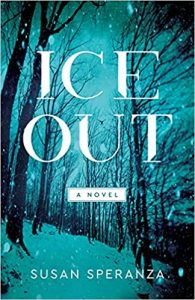Writing and the Art of the Gimmick by Susan Speranza
by Susan Speranza
One recent Sunday afternoon, while doing my weekend errands I turned the car radio to NPR, just in time to hear a report about a university (somewhere in the Midwest) that forces its faculty to justify the existence of their programs, their courses, and their jobs by putting them through a “lifeboat” debate. Once a year, representative members of each department gather before a large audience of mostly students to present arguments as to why the study of their subject is important enough to be saved, should a person be stuck on a lifeboat, fighting for one’s life. Based on the presentations, the students vote which subjects and courses stay and which are eliminated. I’ve heard of many ways in which employees must justify their positions and the work they do, but this was rather unique, because it sought to ask a significant question: what is so important about this or that discipline that a student should devote four years (and large sums of money) studying it?
What should have followed was a series of intelligent arguments from the faculty department representatives. Instead, what was presented by these highly educated people were a series of gimmicks. One member, for example, rode in on a motorcycle, costumed as an Elvis lookalike, another ripped off his shirt while on stage revealing a superman outfit underneath, transforming himself from a mere professor to the familiar superhero. Each department indulged in similar stunts and tricks. The only one to make a gimmick-less, intellectually cogent case was the faculty member who played the Devil’s Advocate. He appeared as himself, in his normal, every-day attire and in a persuasive verbal argument, he advised the audience that they should not vote for any of the others because none of the representatives presented compelling arguments, but merely resorted to gimmicks.
This got me thinking about how the use of gimmicks in every area of society has largely replaced intelligent discourse. A gimmick, by definition, is a device or scheme, which is not designed to convince intellectually, but to manipulate by appealing to a person’s emotions. The connotation is negative; magicians, for example, use gimmicks or tricks to deceive an audience.
Modern writers, too, have embraced the art of the gimmick in order to stand out from the millions of other writers who vie for the shrinking audience of readers and the ever more selective cultural gatekeepers – agents and publishers. To get the attention of these gatekeepers, writers are told they need a perfect pitch. This is essentially a gimmick in which an entire novel is reduced to a catchy one-line sentence designed to entice, attract, and otherwise seduce an agent or publisher into reading the book. The reality, however, is that complex and substantial works don’t readily lend themselves to such a distillation and many a fine book has gone into the slush pile for lack of that seductive, pithy statement. Writers are then told that the opening of their work must “hook” the reader immediately otherwise their audience will stop reading and their work will be consigned to the Do Not Finish pile. Workshops and webinars abound, instructing writers how to fashion such a gimmick as this perfect opening line that will snare a reader. But not all stories warrant such a brilliant beginning. The first sentence of Moby Dick, “Call me Ismael” comes to mind as probably the most famous hook-less line in all literary history. But in Melville’s times the idea of the pitch, hook – or gimmick – to attract readers and publishers wasn’t as prevalent. It was assumed that a reader would read on, see the story through, let it unfold as naturally as life unfolded in those unhurried, technologically free days, the whole of the work then judged solely on its merits.
Present day writers have it harder. Once a book is published, the use of gimmicks ramps up in order to distinguish it from the thousands of others published every year. “Events” are planned for the book’s publication date – book signings that increasingly look more like frenzied Friday night bashes replete with wine, cheese, exotic dishes, desserts, balloons, music and dancing, the flashier, the better to attract attention. Authors are told to give gifts to potential readers – mugs, tote bags, wine glasses, beach towels, boxes of candy– all with the book cover emblazoned on them, a reminder of the reason these gifts are offered in the first place. Book giveaways are common practice, contests where many readers vie for a few free books. However, there are no real studies available that show a positive correlation between giving away a book for free and increased sales or readership, nor is there any compelling evidence that the use of these gimmicks leads readers to the books they really want and need. Yet writers have come to believe that those who are heard best are those who have perfected the art of these gimmicks.
So, in this debate I claim my role as the Devil’s Advocate, and as such I advise readers to vote for none of these, since in-depth and intelligent critiques have given way to mere gimmicks. If ever they are stuck on a lifeboat fighting for their lives with only one book to save, I would hope they, as readers, are able to tear back the veil of trickery and choose a book on its merits alone. One that is gimmick-free, but so substantial that it has the power to save them.
—

Susan Speranza was born in New York City, grew up on Long Island, and for a time worked in Manhattan, enjoying the hectic pace and cultural amenities of the City. Eventually, however, she grew tired of it and exchanged the urban/suburban jungle for the peace and quiet of rural Vermont living. In addition to her latest novel, ICE OUT, she authored two other books: The City of Light, a dystopian story about the end of western civilization, and The Tale of Lucia Grandi, The Early Years, a novel about a dysfunctional suburban family. She has also published numerous articles, poems, and short stories. Along the way, she managed to collect a couple of master’s degrees. When she is not writing, she keeps herself busy exhibiting and breeding her champion Pekingese. For more information visit: www.susansperanza.com
ICE OUT
 Francesca Bodin has a near-perfect life as an accomplished music teacher and professional flutist living in the Vermont countryside with her husband Ben, and their four-year old daughter, Addie. This ends suddenly when a snowmobiling accident traps the three of them in a frozen lake. Ben, after escaping onto the ice, leaves her and Addie to die.
Francesca Bodin has a near-perfect life as an accomplished music teacher and professional flutist living in the Vermont countryside with her husband Ben, and their four-year old daughter, Addie. This ends suddenly when a snowmobiling accident traps the three of them in a frozen lake. Ben, after escaping onto the ice, leaves her and Addie to die.
Francesca believes she sees their dog pull Addie from the lake and drag her into the nearby woods. Desperate to help her daughter, she crawls from the icy waters and follows them. Once she enters the forest, however, she finds herself trapped in a sinister, dream-like world where night never ends, where Addie’s whereabouts remain hidden from her, and where she encounters a group of women who, like Francesca, have been left to die and now seek to unleash their revenge on those who have harmed them. When they have Ben in their sights, Francesca realizes that if she is ever to escape this nightmare and save her daughter, she must first save the husband who abandoned them.
While Francesca’s pilgrimage through this bleak landscape is on the surface a desperate attempt to find her daughter and reestablish her life as it was before the accident, it ultimately becomes an allegorical journey that takes her from despair to hope, from grief to acceptance, and from bitterness to forgiveness.
BUY HERE
Category: How To and Tips




Thank you for this wonderful article. Selling books has most certainly become a circus act in which authors jump through fiery hoops to garner attention.
I do wish it weren’t so! Too much talent goes unrecognized or appreciated.
Looking forward to Ice Out!